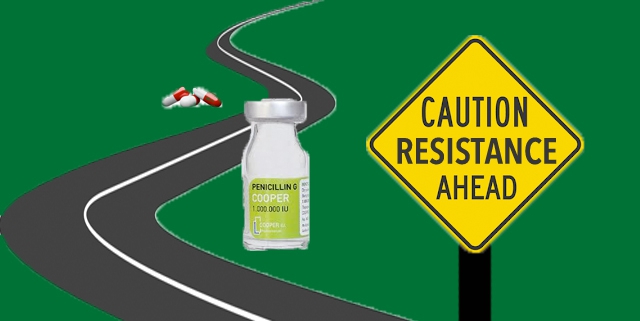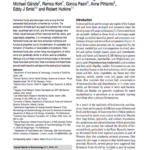Antibiotics: Use with Caution
February 2017. By Karen Scott, PhD, Rowett Institute of Nutrition and Health, University of Aberdeen, Scotland.
Since the discovery of penicillin by Sir Alexander Fleming in 1928, antibiotics have saved millions of lives, and have rightly been described as wonder drugs. Yet since the late 1990s we have become increasingly aware that bacterial resistance to antibiotics is threatening their very use. We can no longer be complacent that we will be able to treat outbreaks of infectious diseases using our existing antibiotic repertoire.
The indiscriminate use of antibiotics in their heyday has led to many bacteria developing resistance to survive. This creates an obvious problem in medicine, where previously treatable diseases become untreatable. The emergence of multi-drug resistant pathogens—methicillin resistant Staphylococcus aureus (MRSA), vancomycin resistant Enterococcus (VRE) and even multiple drug resistant tuberculosis (MDR-TB)—is the result of this problem. Globalization means that no country can solve this independently; it requires a worldwide initiative. European countries were first to recognise that the widespread use of antibiotics in intensive agriculture, primarily to shorten the time for meat production, was resulting in the spread of resistant bacteria to the human population. In response, the EU banned the use of all antibiotics in farming except to actually cure disease, and certain medically important antibiotics, known as “antibiotics of last resort,” were banned completely. As early as 1969 the SWANN report suggested that the use of medically important antibiotics be restricted in agriculture and this came into practice in 1972 in many European countries. This was followed by a complete ban on the use of antimicrobials as growth promoters, first in Sweden in 1986 and subsequently Europe-wide in 2006. However, China and India have actively used antibiotics as growth promoters since the 1990s, after the European ban. Furthermore, unless procedures are put in place that offer alternatives and monitor compliance, such a ban does not work. Prebiotics are one such alternative in animal husbandry, promoting the growth and activity of the ‘good bacteria’ that are already resident in the animal gut.
Without enforcement, many farms find a way around the rules: in the Netherlands, the amount of antibiotics used did not change between 2006 and 2011, the ‘therapeutic use’ simply increased! There are still many countries around the world where there are no restrictions on the use of antibiotics and bacterial super-pathogens continue to evolve, killing people through treatment failures. Bacteria recognise no borders – travellers frequently return with more than what they intentionally packed in their luggage.
The development and overuse of broad-spectrum antibiotics has created an additional problem. They indiscriminately kill not just the target pathogenic bacterium, but many other bacteria the antibiotic contacts. Pair this with our new awareness that humans are heavily colonised inside and out with diverse bacterial populations performing essential functions to keep us healthy, and the problem becomes apparent. In his book Missing Microbes, Martin Blaser posits that the diversity of our microbial symbionts is declining with each generation. The reduction is so severe that bacterial species that colonised our parents may not be around to colonise our kids. If one of those bacteria performed a unique function, that function would be lost as well. Consider Oxalobacter formigenes, a Gram-negative bacterium that resides in our gut and is capable of degrading oxalate and thus reducing deposition of calcium oxalate, the main component of kidney stones. The prevalence of O. formigenes in a population ranges from 38% to 62%, with colonization lowest in people susceptible to kidney stones and in people with greater antibiotic exposure, indicating that the bacterium may be particularly sensitive to antibiotics. Are we dooming future generations to ever increasing rates of kidney stones if we eliminate our saviour bacterium from our gut microbiota?
While we are undergoing antibiotic therapy, bacterial diversity within the gastrointestinal tract decreases, although most bacterial species return to detectable numbers once the selective pressure is removed. However, during the time of decreased diversity our resilience to other infections decreases. One very important opportunistic pathogen, Clostridium difficile, has perfected the art of colonising the gut during the at-risk period. C. difficile produces toxins that affect the gut wall, and its infection can develop into a life threatening disease. It is important that we do as much as possible to alleviate the effect that antibiotics have on the commensal microbiota. One approach is using probiotics. There is evidence that consuming probiotics along with antibiotics can prevent C. difficile infection, possibly by creating a temporary bacterial barrier until the normal microbiota recovers. Despite difficulties in comparing scientific studies with different numbers of patients, different ages, and different probiotic strains, the general benefit is outlined in a recent review.
Overall, we need to reduce the use of antibiotics and recent evidence suggests that probiotics can also have a role here. Analysis of data gathered in 12 separate studies showed that routine consumption of probiotics can reduce the number of people developing upper respiratory tract infections (by 11%), reduce the duration of the infection, and importantly reduce the number of antibiotic prescriptions given out for these infections.
Bacteria are very resilient. Faced with extinction due to antibiotic killing, they will try everything to survive. They can acquire resistance genes from neighbouring bacteria lucky enough to contain them. They can even play dead by changing into spores: dormant, non-replicating bacterial forms that cannot be affected by antibiotics, and which can regenerate once the antibiotic pressure is removed. These strategies mean that bacterial antibiotic resistance is here to stay. In order to keep ahead of the game and make sure that antibiotics remain effective in treating infectious disease for our children through to our great-great-great grandchildren, we have to act now, saving antibiotics for situations where they are really needed. It may well be that probiotics and prebiotics will help us to do this.







